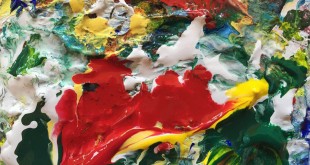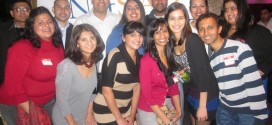By Jennie L. Ilustre
University of California, Santa Barbara (UCSB) Professor Shuji Nakamura, who shares this year’s prestigious Nobel Prize for Physics with two Japanese researchers, has an inspiring message for Asian Americans.
“I encourage higher education and hard work in order to achieve the American Dream and thrive,” Nakamura, 60, said in an interview days after the announcement of the award on October 7.
Japanese American Professor Nakamura and Japanese researchers invented blue light-emitting diodes (LED) in early 1990s. The two other Nobel laureates are Isamu Akasaki of Meijo University and Nagoya University in Japan and Hiroshi Amano of Nagoya University.

How world-changing is their invention? For one thing, without their invention, there would have been no cellphones, smartphones and Blu-ray movie discs.
The Nobel laureates are all Japanese by birth who worked in Japan at the time of their discoveries. Nakamura earned his bachelor’s degree, as well as his master’s and doctoral degrees in electrical engineering, from the University of Tokushima, Japan. All three will receive the award on December 10 in Oslo, together with other Nobel laureates. They will also share the total prize of a little over $1 million.
The prize is named after Alfred Nobel, the Swedish inventor of dynamite.The Royal Swedish Academy of Sciences was founded in 1739 as an independent organization. Its goal: To promote the sciences and strengthen their influence in society.
The Academy noted in its website, Nobelprize.org: “Despite considerable efforts, both in the scientific community and in industry, the blue LED had remained a challenge for three decades…They (Japanese laureates) succeeded where everyone else had failed.”
Bulbs using blue light-emitting diodes are very energy-efficient. LEDs last for a maximum of 100,000 hours, according to the website. Incandescent bulbs only last for 1,000 hours. Even fluorescent lights pale in comparison at 10,000 hours.
The committee said LED lamp “holds great promise for increasing the quality of life for over 1.5 billion people around the world who lack access to electricity grids.” As an energy saver, it can be powered by cheap local solar power. The “new energy-efficient and environment-friendly” inventions “were revolutionary,” the committee stressed. “Incandescent light bulbs lit the 20th century; the 21st century will be lit by LED lamps.”
Akasaki worked with Amano at the University of Nagoya. Nakamura was employed at Nichia Chemicals, a small company in Tokushima. Rachel Feltman, who runs The Washington Post’s Speaking of Science blog, noted that all three men continued to improve on their work during the 1990s. They also independently created blue lasers, whose blue light’s short wavelength store four times more information than infrared light. One result everyone is familiar with is the Blu-ray movie discs.
Professor Nakamura
An email interview with Professor Nakamura follows, thanks to the cooperation of UCSB Deputy News Director Andrea Estrada and Yukina Warner, Corporate Programs Manager of UCSB Solid State Lighting & Energy Electronics Center.
Q: What difficulties did you encounter before you succeeded in your LED invention? Please relate a story of one difficulty you faced, and how you solved it.
A: A commercially based reactor cost $2 million in the 90s, but the quality of the crystals I tried growing was poor. I modified the reactor and spent 1.5 years trying to grow quality crystals–this was a difficult time for me. One year later, I invented the 2-flow reactor. At that time, I started to grow the highest quality GaN crystals. Since then, I’ve been at the top of my field.
Q: What is your message to Asian Americans–or anyone, for that matter –about the importance of never giving up in achieving one’s dream or a goal?
A: I encourage higher education and hard work in order to achieve the American dream and thrive.
Q:What do you intend to do with your 1/3 share of the prize?
A: I plan to continue researching energy-efficient devices.
Q: What project are you currently working on now?
A: Research in solid state lighting, namely improved LEDs, laser-based lighting, and growth of bulk GaN crystals.
In her story published in the UCSB website, Andrea Estrada reported Professor Nakamura is “known for his technological achievements with semiconducting gallium nitrides.” Nakamura is “widely recognized as the world pioneer in light emitters based on the wide-bandgap semiconductor gallium nitride (GaN) and its alloys with aluminum and indium.”

Photo courtesy of UCSB
Pride of UCSB
In her story in the website, Ms. Estrada said Nakamura is the sixth faculty member to have won a Nobel Prize since 1998. UCSB alumna Carol Greider received the 2009 Nobel Prize in Physiology or Medicine.(For the entire article, visit www.news.ucsb.edu/2014)
Nakamura, who is also co-director of the university’s Solid State Lighting & Energy Electronics Center, credited his success to people who have supported him over the course of his career, according to Ms. Estrada’s story. “I got my first break from Nobu Ogawa, chairman of Nichia, who supported my gamble to make a blue LED,” he said.
He added: “Also my young colleagues at Nichia helped a lot. I am also grateful for the support of UCSB Chancellor Henry Yang, and the Solid State Lighting and Energy Electronics Center, which has continued to support my research on LEDs and lasers, and my dream of LED lighting.”
UCSB Chancellor Henry T. Yang was in Hawaii as chair of the Thirty Meter Telescope (TMT) International Observatory, and was not present at the press conference. Executive Vice Chancellor David Marshall read Yang’s statement: “Dr. Nakamura has helped to pioneer a scientific revolution in solid-state lighting, with far-reaching impact on fields ranging from information and communication, to energy and the environment, to health care and life sciences,”
“By making it possible to bring affordable, energy-efficient LED lighting to developing countries, Professor Nakamura has also made a tremendous humanitarian contribution to our world,” Yang added.
Nakamura is also a member of the Lighting Solutions Group within UCSB’s Institute for Energy Efficiency. Nakamura joined the UCSB faculty in 2000. A year later, he was appointed to the Cree Chair in the Solid State Lighting and Display Center.
At presstime, National Federation of Filipino American Associations (NaFFAA) National ChairmanJT S. Mallonga paid tribute to the Nobel laureates. “We congratulate Isamu Akasaki, Hiroshi Amano and Shuji Nakamura for their tremendous achievement, a significant milestone in modern technology,” he said from New York. NaFFAA is based in the nation’s capital.
“As a community, we take immense pride in their pioneering spirit–a practical invention that has universal and wide-ranging applications,” he added. “We wish them more success in their future endeavors.”
 Asian Fortune Your source for all things Asian American
Asian Fortune Your source for all things Asian American



